
Bob writes: I have a life long passion for the outdoors through rock climbing and fell running. A cancer scare in my thirties made me appreciate many things I simply hadn’t noticed before, from the smallest plants to the gap in the sky from a missing raptor. It’s all worth fighting for and that’s what I try to do.
I learnt a new phrase last week – Public Goods. This is being used in DEFRA led discussions about the future of our rural environment post Brexit. For our uplands Public Goods are the value to the wider community, of any part of that environment. Looks like DEFRA have been listening to Chris Packham all along, Chris of course talks about Hen Harriers as our national treasures.
In these two guest blogs, I’ll take a look at some landscape scale developments which have affected the Peak District National Park and also local problems in more detail. Taken as a whole we can then see how this impacts the communal value of this area.
Two surfaced roads were built recently in the north east peak and this prompted the National Park Planning Authority to issue guidance recently (not yet online). The Authority has a duty to preserve the landscape and character of the park. Mark Avery often talks about grouse shooting as recreation and you’ll see that the House of Lords agree in their ruling Earl of Normanton v. Giles 1980. This is crucial as many agricultural and forestry activities do not need planning permission, but shooting does. This guidance is specific to the Peak but the Yorkshire Dales National Park should work in the same way and beyond the national parks each local authority will have the same responsibilities. This opens up another avenue to get moorland roads removed if Natural England are not helpful. You will need photographic evidence, the crucial thing is to show the route was unsurfaced previously. Google Earth or Getmapping can provide historical aerial images. It helps to see your MP and have their name copied into all emails, this means you’ll get a reply in a week rather than 6 months. You will probably find there is a time limit on this type of action.
You will have already seen this plastic track that was created at Midhope. This track is a direct consequence of intensive grouse moor management. Habitat was being damaged by repeated vehicle use. I would have thought the obvious solution was to stop the vehicles, but instead this unsightly eyesore was created across the valley.
The National Park has now started enforcement proceedings to have the road removed and the land restored.
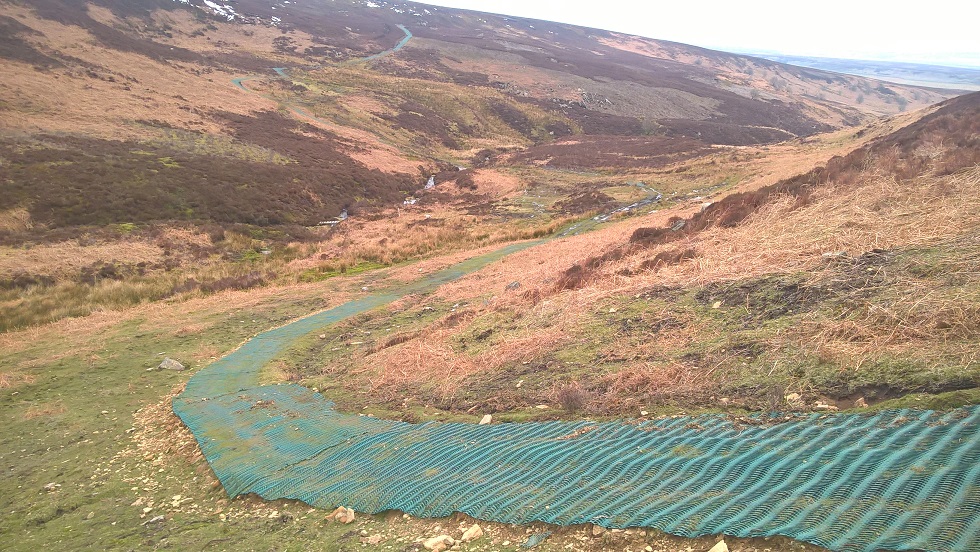
Natural England paid for this track via High Level Stewardship grants, this is public money, in other words you and I paid for it. Anyone care to submit an FOI to find out how much of our money was spent here? And of course this is now even more relevant – the question is how much of our money was wasted here? The track is located in the Stocksbridge and Penistone constituency where Angela Smith is MP. Wouldn’t it have been great if Angela had been able to raise these questions in the Westminster Hall debate last year?
At Strines vehicles had been damaging protected blanket bog over a decade as this Google Earth image shows. The route that was eventually surfaced is the right hand line and you can see some of the logs that were placed in the worst sections. Once again why was the landowner not told to stop the damage to this protected environment?
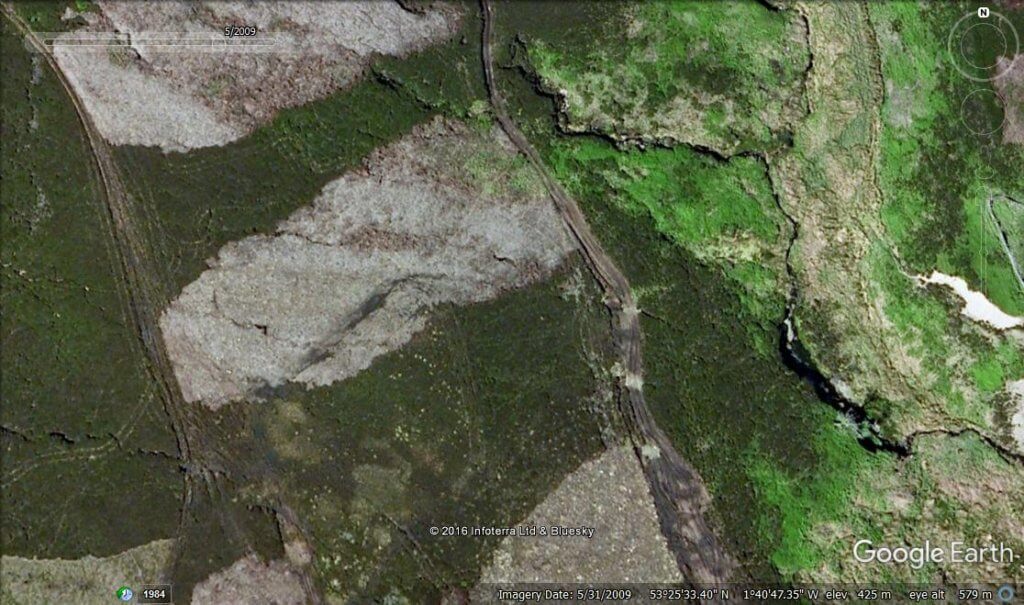
You and I have now paid for the damage of the parallel routes to be repaired as part of a moorland restoration scheme. The surfaced road changes the whole landscape here. In this case the surfaced route was funded and built by the landowner.
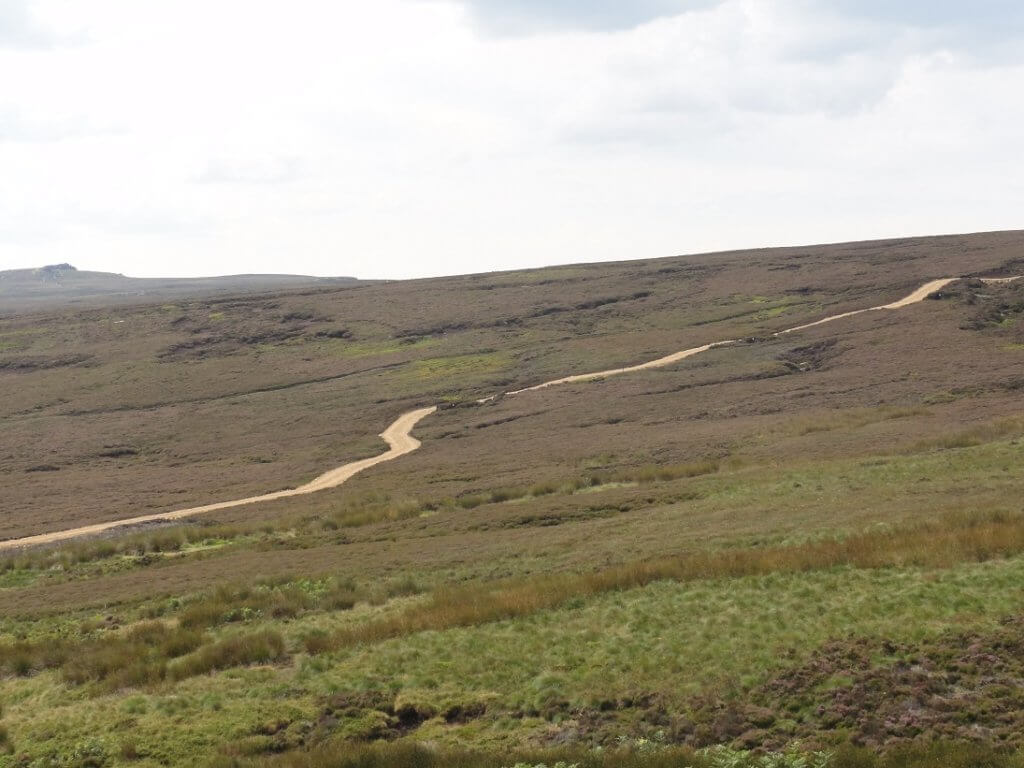
Natural England’s own research paper (NEER002 The Impact of tracks on the integrity & hydrological function of blanket peat) defines this construction as a Heavy Duty floating road (gravel on logs or bare peat). A massive amount of stone has been used, up to 1 metre depth in places with a likely density of about 1 tonne per metre of track and total stone of around 1000 tonnes used over 1 km.
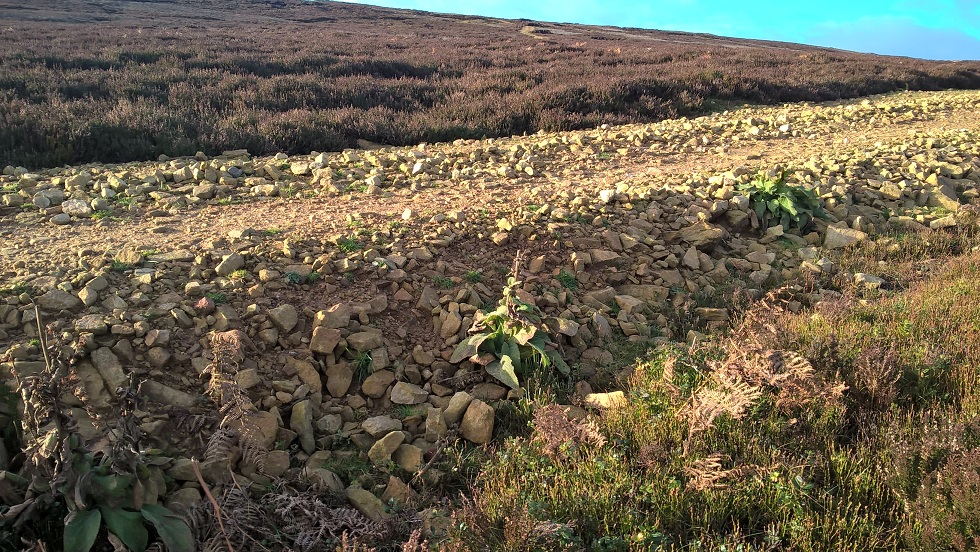
Compacted gravel and the compacted peat underneath inevitably change the hydrology of the blanket bog, acting as a barrier to the normal underground permeation of water. Blanket bog is our most precious habitat. Millions are being spent to make the moors wetter and to try to encourage more sphagnum and environments that will start to regenerate peat instead of seeing it all being washed away.
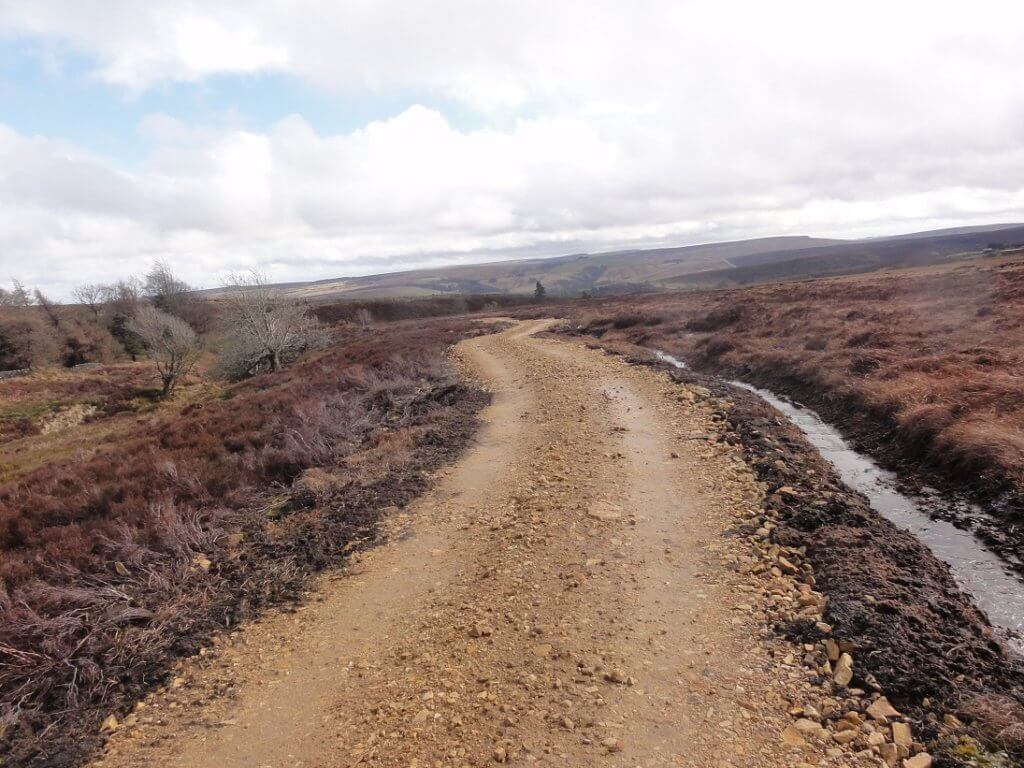
Why is this road still here when it permanently damages this precious landscape? The only action Natural England have taken is to partially block the drain at the side, but even that’s dodgy as there are a series of pipes under the road with entry/exit concealed under flat rocks. If these drains were blocked, the road would be washed away.
With a lot of work and help from Nick Clegg I have managed to get NE to start talking to the National Park about getting the road removed. It’s quite likely this will result in a public enquiry and given the Walshaw experience, who knows how that will end?
Just as the peat is being eroded from our moors, this intensive grouse moor management is eroding the communal value of this rare environment.
To be continued later this week.
[registration_form]
Marvellous work, Bob, well done. Disgusting that our taxes have paid for this desecration.
These ugly roads serve no purpose except to ferry grouse shooters a few times a year. They are environmentally damaging and unsightly. Well done Bob for drawing attention to this issue, hopefully some will be removed as a result of your hard work
No Barbara, there is another use. Gamekeepers can sit in their landrovers and monitor and shoot birds of prey without getting wet and cold.
Excellent work Bob but very disturbing that public money used in this way in what supposed to be a heavily protected and fragile environment.
Cracking article Bob, best of luck and am shocked that approx thousand tonnes of rock used for road to help people shoot grouse. What a waste time, effort, resources and money – lot better deserving causes than this!
Les – that’s your 400th comment here. Thank you.
Quantity over Quality!!! Thanks for giving me the opportunity to make them and poor you you’ve had to read them all!
What I like about Bob is that he actually tries to do something about the moorland damage, rather than just having a moan. I hope he succeeds in his quest to put right the damage, though I really couldn’t imagine all that stone being removed without causing lots more damage to the surrounding landscape.
And Bob, if the nasty brigade are tasked to remove the plastic surface at Midhope, then please put a requirement in that the material be recycled rather than just piled on a great bonfire to pollute the fresh moorland air.
What a total waste of taxpayers money, and at the hands of our grouse shooting-interested Conservative government.
Andy, it’s a valid point about damage that may be caused by removing the stone. It is unconfirmed at the moment but the stone may well have been quarried on site less than a mile away. If this is the case it won’t have to travel far to be put back. The road is already showing signs of deformation with materials from underneath now poking through the surface. NEER002 is an odd report but lists numerous examples of problems including catastrophic failures of this type of road construction on blanket bog. It would be great to hear an expert opinion but seems likely there will be ongoing problems. Last November’s raptor conference in Durham showed similar type roads that had appeared in that area. It’s not an isolated problem and it’s a mess in every sense of the word.
So, you want to add climbers to the ‘banned’ list? Well lets add a few more to the list should we, like anyone who ventures into the countryside and has the cheek to walk and further erode the footpaths.
While we’re at it, lets dig up all those man made pedestrian highways that ruin the fells, together with the artificial roadways allowing access to communication masts and wind turbines.
Not forgetting of course the ever increasing number of off-road bicycle trails which also scar the environment.
My pet hate is people letting their dogs run all over the moor from March onward. There are usually plenty of signs asking people not to do this. Moors like those round Stannage, Burbage, Redmires are absolutely not places you go seeking solitude. Not far from Manchester and semi-urban areas like NE & SE Derbyshire/W Notts and I noticed the other day driving from Hathersage to Foxhouse a “Welcome to the City of Sheffield” sign, so virtually “within” Sheffield, these moors must be under more pressure from people than any other in the country. Managing this is obviously a challenge but in this area I have seen ring ouzels on Stannage and Burbage, good numbers of breeding woodcock locally, Pied flycatcher, wood warbler, merlin, hobby, kestrel, cukoo, crossbill, peregrine, raven, hen harrier, lots of lapwing and curlew, spotted flycatcher, even a common scoter and numerous other birds. The thing is the people generally stay within quite restricted areas. They usually stick to the paths. I think the whole of the Eastern Moors, except East Moor and Beeley Moor which belong to Chatsworth, is run under the Eastern Moors Partnership consisting of amongst others the RSPB and National Trust. It will be interesting to see how the wildlife develops over the coming years bearing in mind the pressures from people.
It might interest you to know, plastic roadways are designed for use on a temporary basis only. They are not designed to be laid as a permanent access solution.
Bob,it would be nice if you cleared Stanage edge of all those climbers.
Probably the best place in the Peak for Ring Ouzel if those climbers went other places.
Could even be one of the best places for them in the country.
Of course a car park full of climbers would say oh no we are careful not to disturb them.
Rubbish but partly true,why would any Ouzel go amongst a crowd of shouting people.
Dennis, how did we get onto Ring Ouzel? I’m not a life long border or ecologist, but I am in my own way, trying to make the uplands a better place. If we preserve the habitat then there is more chance for the wildlife to do better as well. Regarding Stanage about 15 years ago a massive amount of work was done to produce a new management plan. There was strong and apparently conflicting demands from conservation and recreation. What transpired is a lesson to us all. A massive amount of work was done by the British Mountaineering Council and Bill Gordon, peak park ranger. If a Ring Ouzel is being territorial a few metres either side of it’s chosen rock are roped off and the birds seem to nest there quite happily even though a lot of people are nearby. Over ten years I have regularly asked Bill why any nest failed, the answer has invariably been predation, with Weasels usually identified as the culprits. Disturbance is not identified as the problem. Of course this then opens up the question if we would like to see dozens of spring traps here as there are on grouse moors. Stanage is enjoyed by 500,000 visitors a year. Bill Gordon appeared in a BBC Countryfile Diary programme last year.
Natural England what a disgrace,nothing natural in your actions the paths are a mess
The internet/social media has created a base for the masses to jump into what were relatively low-key activities.
For example: my beloved fell running; I know I’m part of the erosion/disturbance problem, but I’ve become overwhelmed at the sheer number of recent newcomers to the activity. When I first started fell racing, nearly thirty years ago, there were relatively few participants. I think Bob Berzins would agree with that, in fact Bob was one of my fell racing heroes, a prolific racer of the long Lake District fell races.
It’ll be the same for climbing, mountain biking, walking, photography (drones), all increasing massively in numbers of participants over the last few years.
Add into the mix the relatively dominating landscape changes by the grouse shooting fraternity and what’s created is a constant disturbance for the fragile wildlife.
Birds such as Ring Ouzel will not tolerate disturbance of any kind.
It’s a shame but that’s how it is, and it isn’t going to get better in the near future.
We need more managed reserves where sporting activities, such as those mentioned above, are restricted in order for our native wildlife, including predators, and declining Ring Ouzels, to remain at sustainable breeding numbers.
And I seriously believe that driven grouse shooting HAS to be banned as soon as possible.
If peoples’ enjoyment has to be restricted then so be it.
Our moorlands need more people like Bob – folk who regularly go out onto our moors and uplands and are willing to record and report the damage they see being done to these protected landscapes by shooting interests. (SSSI/SAC/SPA and all that).
I know from talking to some Natural England staff in the Peak District that they are utterly ashamed at how this once fine organisation (which should ostensibly put the environment first) now only seems willing to take the path of least resistance in enforcing rules designed to protect these priority habitats. I recently saw one email from a NE Area Manager to an MP which made it clear they weren’t willing to implement enforcement action because of the damage that enforcement might then do to the surrounding habitats. He (RM) said “removing the stone, which is now compacted, would in our opinion cause greater damage than leaving it in place.” How about making an example of these estates, Rob, if they overstep prior agreements? Wouldn’t that dissuade others from causing similar damage in future? Or have you been instructed from on high not to make waves?
NE clearly seems to regard all these major trackworks as simple “repairs” that don’t need planning permission (so any rutted, historic old track in existence before SSSI designation now seems fair game to NE for upgrading to M1 status for lazy gamekeepers and monied clients in a rangerover). If it doesn’t have the bottle (or permission from Defra) to demand their removal when they clearly exceed any agreements, then Natural England is clearly not fit to oversee the management of these protected upland habitats. But who else is?
If you care about what happens on other Peak District moorland (owned by the National Trust), then do please sign this petition: https://you.38degrees.org.uk/petitions/no-moor-management-for-grouse-shooting-on-two-national-trust-estates-in-derbyshire
You should see Some of The Roads the Duke of Westminster was allowed to construct on the Abbeystead Estate, by NE. You could run a Bus service on them.
Bill – many thanks!